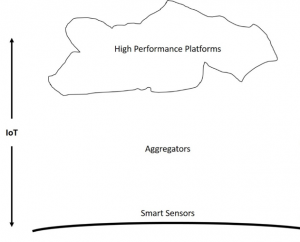Critical Link pretty much cut its product development teeth on DSPs. Although we have branched out since then, we still do plenty of work with DSPs. And we still remain grateful to (and admiring of) Gene Frantz who, while at TI, pretty much invented Digital Signal Processing. Gene retired a while back, but he’s not exactly kicking back in his retirement. Among other things he’s worked on is an excellent set of posts on the Internet of Things which ran last spring/summer over on Embedded Computing. Don’t know how I missed these the first time around, but I’ll be making up for lost time by summarizing some of Gene’s post, starting with his definition of the IoT:
It is a system that consists of three different groups of sub-system components:
- Clouds
- Aggregators
- Smart sensors

Each of the above sub-system components is necessary for the overall IoT system to function optimally. The cloud is the ultimate computing unit and universal communications network. The smart sensors are the interface to the real world. Finally, the aggregators are the go-betweens. To the cloud the aggregator looks like smart sensors and to the smart sensors it looks like the cloud.
In his next piece, Gene drills down further on this definition, starting with his characterization of the IoT as “a system of systems”, and his view that “any of the two IoT components functioning together without the third can be a complete IoT system.” He gives a couple of examples of how the components in an IoT “system of systems” work together, then points out that each of the different IoT components – smart sensors, aggregators, the cloud – have distinctive considerations when it comes to performance, cost, power dissipation and size:
- The cloud system focuses on performance. Therefore, cost, power dissipation and size are at best secondary concerns.
- The aggregator system is less concerned on performance and power dissipation and more on flexibility.
- The smart sensor system focuses on battery life, size and cost, making performance a distant third in priority.
By the way, the sample applications Gene uses are interesting ones. I don’t know if the coffee shop with a smart “infinite cup of coffee” exists in real life or just in Gene Frantz’s head, but I’m guessing that at some point in the future there’ll be one on every corner.
In his third definition piece, Gene asks the question about the number of systems that make up the IoT. If you’re looking at the overall IoT, there are an almost Carl Sagan-esque number of devices that are part of the IoT: an estimated 8+ billion in 2017, thus a lot more today. For the most part, in this post, Gene addresses the complexity of arriving at an exactly precise count (or an exactly accurate ) for the Internet of Things. One thing that contributes to this complexity is sometimes an “aggregator looks more like a smart sensor than an aggregator.” Or the “aggregator may look like the cloud.” Then there’s the fact that “a network of smart sensors [may] act both as a smart sensor and at the same time as an aggregator.”
Let’s just stick with big and complex.
I’ll be drawing on other posts in this series, but I do encourage you to read Gene Frantz’s work here, which is clear, straightforward and interestingly presented. Meanwhile, thanks again for DSP. Critical Link wouldn’t be where we
